I’m on a 10 day trip around Belgium and just arrived in Ghent from Bruges. Now I totally loved Bruges, to the extent that I didn’t want to leave so soon! But, let me tell you, when I arrived in Ghent, I felt right at home! The gothic architecture, the student vibes, the amazing food culture….with Ghent you just can’t go wrong. There are so many things to do in Ghent that you could spend three days or more and not get bored!
Disclosure: templeseeker.com is a participant in the Amazon Services LLC Associates Program and other affiliate advertising programs designed to provide a means for us to earn fees by linking to Amazon.co.uk, Get your Guide and other affiliated sites. Affiliate links may be used in this article on ‘Things to do in Ghent?’, but they do not impact on the price that you pay and they do help me to get this information to you for free.
Many people who travel to Belgium see Bruges and Brussels, but miss the best city – Ghent. What a pity!
The good news is that even if you don’t have a few days to spare, Ghent is also worth doing as a day trip from Brussels. It’s just half an hour away by train, and the old historic part of Ghent can be seen in just 2-3 hours on foot. So, what are you waiting for, get yourself over to this European haven!
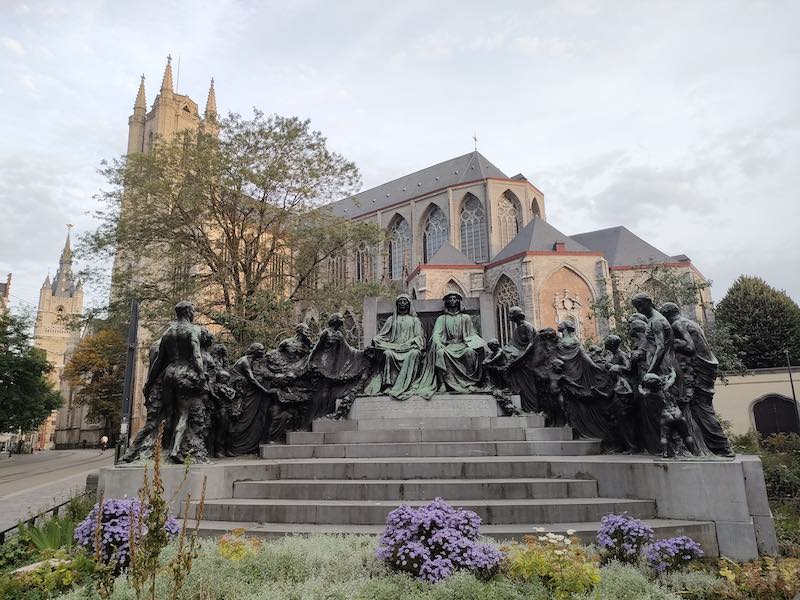
Photography copyright: All the images in this blog are original photography by Amy Green and are property of @templeseeker (unless otherwise stated). Please do not use these without permission or without giving credit. If you would like to use any of these images please email: amy@templeseeker.com for permission.
Things to do in Ghent
There are certain things in Ghent that you absolutely should not miss, including climbing Ghent Belfry and visiting Gravensteen castle. But as well as these things to do in Ghent, I would also encourage you to take a walking tour. You will learn a great deal about the city of Ghent, and also find unexpected places that you wouldn’t have otherwise been aware of. Free walking tours with Legends Tours (tip based) go from outside Hostel Uppelink (on St Michaels Bridge) at 10.30am daily. The walking tour is approximately two hours, with a few stops to learn about history on the way, so good footwear (preferably walking boots) is recommended.
Oh, and if you are pushed for time, you will be pleased to know that you can see the highlights of the city in just one day. If you want to do this then check out my article on how to spend one day in Ghent.
St Michael’s Bridge
The view from St Michael’s bridge will astound you in literally every direction. From there you will see the three main towers of Ghent – on the left is the Cathedral of St Nicholas, next in the middle you have Ghent Belfry and thirdly, St Bavo Cathedral.
The Riverside houses and Tax House
With the Belfry in front of you, take a left down the stairs to the riverside where you will see amazing houses from the 11th-16th Century. Notice the stepped gables on the roofs of the buildings. There was no practical use for these, they were simply decorative – to show off! Brick was expensive at that time, and so the more they had, the more important and wealthy they seemed! Along the riverside of Ghent you will see some of the earliest stepped gables in Europe, dating back to the late 13th or early 14th century.

The tax house was the place where they would weigh the grain that was being transported through the city and retain 25% of it (the grain tax). Now, as expected, the tax house was a much hated building and so they made it tiny – look for the small building with blue windows. It is also leaning forward so that they could extract the grain (have a lift). They used to pull it up manually unlike the pulley systems they developed at a later date in Amsterdam.
Climb Ghent Belfry
Ghent Belfry is worth climbing for the fantastic view that you get from the top. The Belfry tower is 91 metres high, making it the tallest Belfry in Belgium and it gives a fantastic view of the city. It is part of a group of French and Belgian Belfry buildings that are UNESCO World Heritage protected.
Entrance fee: 11€
Town Hall – Built in two architectural styles
What is interesting about the Town Hall (Stadhuis) is that it was built in two architectural styles – the first narrow part (the Hoogpoort side) was built in the 16th Century in Gothic style and the second latter part with (with Doric, Ionic and Corinthian columns) is in the Renaissance style (built between 1595 and 1618). So why the sudden change of styles? This is related to the history of Ghent.

The story goes that in the 16th century, the city was hit by an economic recession. During the Ghent revolt, the citizens of Ghent refused to pay taxes imposed by the emperor. They were marched around the city with nooses around their necks. The citizens of Ghent would not beg for mercy, and so the symbol of the noose is actually a symbol of pride in Ghent today.
During this time, 5000 Spanish troops entered the city. So, the city hall was built late gothic, then the money was taken and then the new part built in renaissance, when the people of Ghent got back their money!
Gravensteen Castle
Gravensteen castle is one of the most famous buildings in the city. It was built in 1118 mainly because the people of Ghent were quite rebellious, so the castle was built to keep an eye on them! In front of the castle is the ‘Square of Death’ where the executions happened.

The castle has served several different purposes over the Centuries. As the ‘Square of Death’ was near, Gravensteen became a court. Then at the start of industrial revolution, it became a cotton mill factory. There was a fire at that time and the castle started falling apart and some of the little towers started to fall off.
The people wanted to take it down but the city wouldn’t let them – they wanted to restore it and so the city rebuilt it. However, they ran out of stones so they took them from the pavement and the streets! This can be noticed if you look closely at the difference in brick between the walls and the small towers!
In 1949 there was an invasion of the castle…wait for it…by the students of Ghent! Why? Because the city wanted to raise taxes on beer by 20%. The students gathered rotten fruit and veg to throw at the police!!! In the end they knocked the beer tax down to 15%! Thanks to them we still have democratic prices on beer!
If you visit the inside of Gravensteen castle, you can see the execution devices used in the Middle Ages. You will also get an audio guide with the voice over from a Belgian comedian with a lot of black humour. The audio guide is available in several languages including Dutch, English and French.
Oude Vismijn (The Fish Market and Tourist Information Centre)
Over the road from Gravensteen Castle, look out for the old fish market. It has carved fish on the outside of the building including lobster, plaice, crab and shrimp.

Around the corner, you will see the entrance to the old fish market which now leads you to the tourist information centre and a beautifully located cafe on the river. The Baroque style gatehouse has a carving of Neptune in it. Two other sea gods existed below, but were destroyed by fire in the 1800s and so they were replaced by alternative carvings.
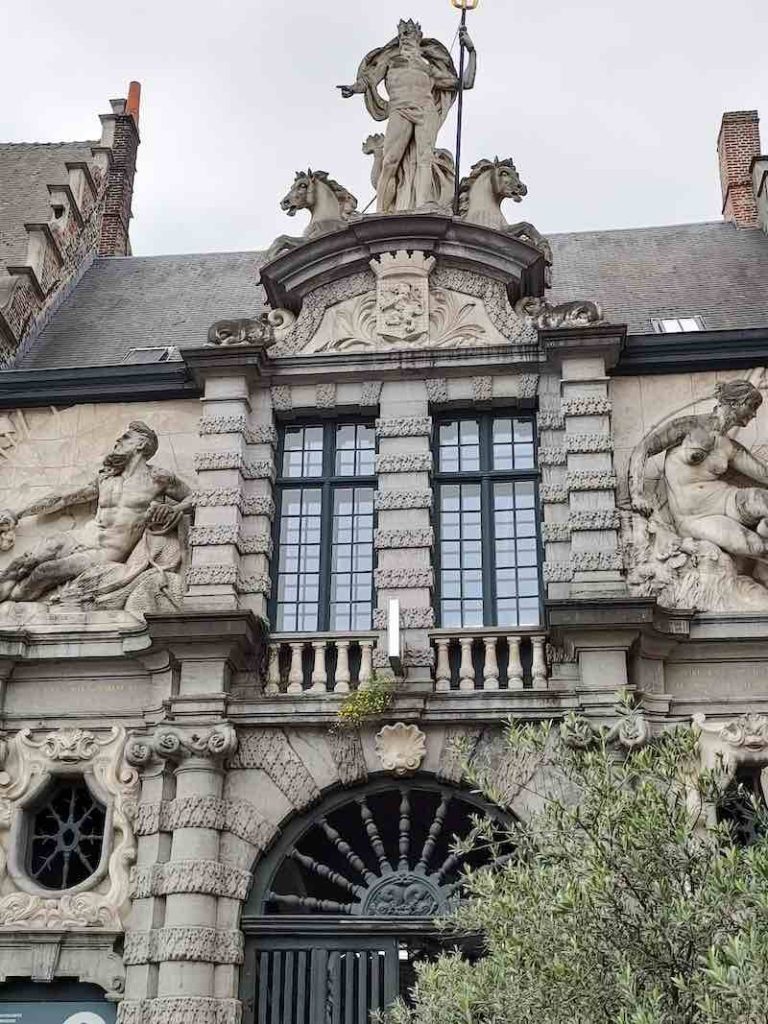
The tourist information is there and they have maps, information alongside other maps of the painting for the adoration of the mystic Lamb.
The Old Meat Market
The Old Market is further down and next to the Galgenhuis (gallow house). They used to divide the meat up and give the good meat to the rich and the bad meat to the poor. And yes, what is now Cafe Galgenhuis WAS actually the gallow house, and so they had hung dead bodies right next to the meat market!
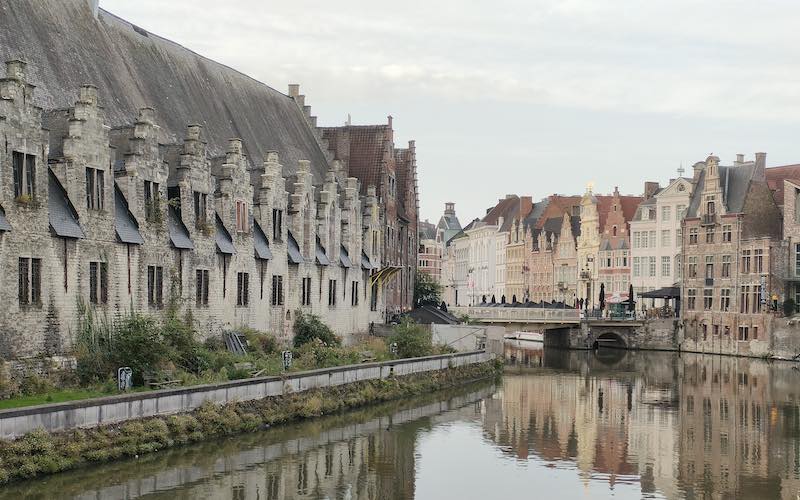
There was a woodworm infestation case and so you cannot go inside anymore. When it was open to the public more recently, it used to be a restaurant and a shop (promotional centre for regional products). These have now moved to another place in the centre.
Graffiti Alley and Street Art
Graffiti alley is just 5 mins walk from the town hall and is a place where numerous budding street artists all have a practice. This was an initiative back in the 1990’s to give artists an area where they can legally practice street art. The only rule is if you do it there and cover something up, then you have to make it better than what was there before! Although the quality of the art is not always the greatest, it’s a really cool place to walk through and see the artists work as they develop and progress.

There is also some more professional street art to be found. Look for See Pia ‘The Lion’s Den in Patershol, ERICA II CANE & BASTARDILLA and A SQUID CALLED SEBASTIAN: THE TRAVELER. You can find out more about the street art of Ghent here.
Beautiful Old Houses on Kranlei
There are two old houses on Kranlei which are worth a photo stop. The one on the left was an orphanage and is now a sweet shop. The images carved onto the building show to look after the hungry, the thirsty and the naked.

The one on the right was the alchemist store – somewhere between a lab and a chemist shop. The images show the five senses – sight, smell, touch, hearing and taste. There are other symbols (including a man playing the flute) which had meaning in the apothecary world at the time. Now this building is a Thai restaurant.
The Ghent Cannon
The Cannon that you see by the riverside was made a little prior to 1500, and at the time it was the biggest cannon. The Spanish troops were about to invade Ghent and so the people of Ghent went to get the cannon (they stole it) – which is quite remarkable as it is quite a size. Nevertheless they got it ready to fire at the invading Spaniards. But when the day came that they they wanted to use it, the cannon ball only flew a measly 2 metres! The Cannon became a symbol of Ghent.

The cannon of Ghent has been blocked off now at the end. Why? Because drunk students used to get in it and pass out and sleep in there! It was very close to the Friday Market where all the pubs are. The poor students can do this no more!
Vrijdagmarkt – Friday Market and the Workhouse
The Friday Market is a good spot for finding pubs and watering holes. The Dulle Grit pub is found on Friday Square. This is the place you can order the 1.2 litres of ‘Carriage Beer’ served in a long tube. But be prepared to temporarily give up one shoe as a deposit for the glass!
In the centre of Friday Square is the statue of Jacob van Artevelde, the leader of the textile industry and he is pointing to England, due to his affinity with the English over the French (for economic reasons). During the industrial revolution, Ghent was the second city after Manchester to start the Industrial Revolution.

England was famous in textile industry. A man called Lieven Bauwens, organised a group of spies to go over to England and took a piece of a spinning wheel, 40 trips and 40 pieces. Finally he rebuilt the spinning wheel, but he didn’t have staff who could use it. He went to England and offered the workers double and took them to Ghent. BUT eventually he trained locals and sacked the English and paid the locals and children cheaper. After that, he sold all his factories and paid all his debts and went back to Paris. This is basically what when on in the large workhouse that you see from Friday Square.
It’s worth bearing in mind that Dutch languages in the Middle Ages became the language of the working class. The richer people were French speaking bourgeoisie. Even today, in some cities in Flanders, it’s better to speak English rather than to start speaking in French!
Bavo Cathedral
The Bavo Cathedral is named after the monastery and is a UNESCO protected world heritage building that dates back to the 11th Century. The materials used to build it and the artwork inside are what makes it very special.
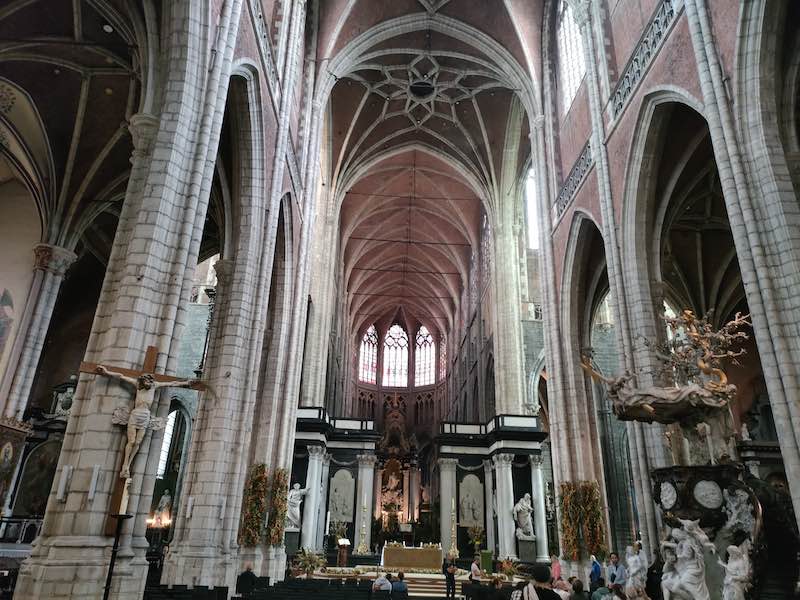
Adoration of the Mystic Lamb is inside and it’s a masterpiece of medieval art, which was completed within twelve years by the Van Eyk brothers. The piece was commissioned by a wealthy married couple who didn’t have children, but wanted to keep their legacy alive. As with many important paintings, it has been stolen several times. It was stolen by the crew of Napoleon and brought back. Later, the Nazis stole some panels and they finally found them in a salt mine in Austria. Finally, some random guy from Ghent stole a panel and held it to ransom. The city did nothing and so this panel is still missing. On his death bed, the thief was asked where it was…but he didn’t finish his sentence. He popped his clogs before the answer came out of his mouth! So….if you find it please bring it back!
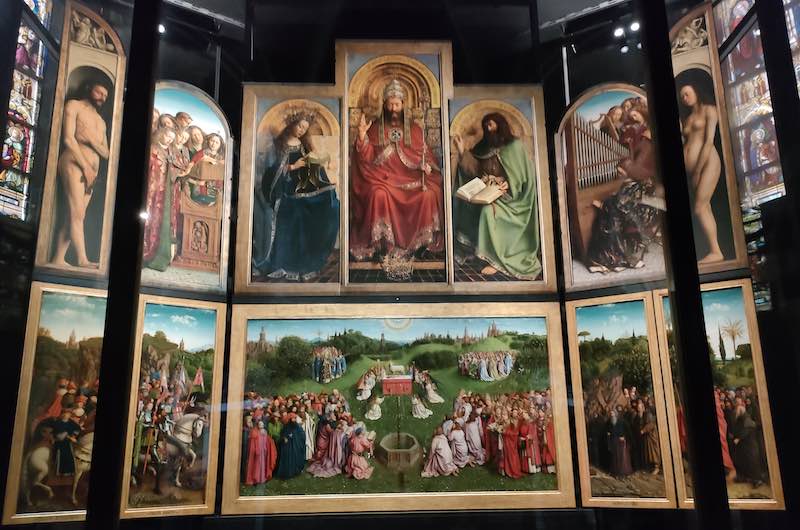
In the back of the Cathedral on the left, there is an entrance for the painting. It costs 12€ to see it, which is well worth the money as there are other pieces of art in there also. You can also pay 16€ for the augmented reality tour. Our guide told us that it’s better to see it with the augmented reality, because you learn about it and the symbolism. But I am not a fan, so I skipped the augmented reality tour and went straight to seeing the painting. You get a booklet when you visit, which explains each of the panels and so to me, this is all that you need to do.
Kayaking or boat trip down the river
A fantastic way to see the city and to learn about it is to take a boat tour. They cost between 9-12€ (depending on what company you use). You can just turn up on the day as boats with guides run daily up and down the canals. If you are feeling a bit more adventurous, you can hire a kayak and explore the canals yourself. There are only really two ways that you can go, so you can’t get lost. You can book kayak tours that go from Hostel Uppelink on St Michaels bridge.
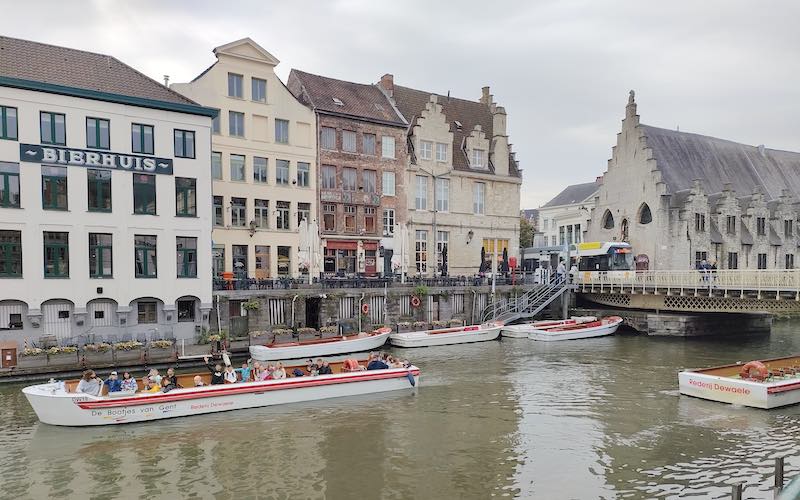
Ghent Food tour
Ghent was abundant with food before the Spanish invasion, which bought numerous jobs including butchers, bakers and even textile workers. They also taxed passing boats at a high rate of 25% which helped the city to flourish. And flourish it did! With numerous amazing dishes such as moules-frites, Belgian fries and Flemish stew, waffles and chocolate. I’ve said it before and I’ll say it again…you’re not gonna lose weight here!

You can read more about food in Ghent here.
Hit the Pubs for some Belgian beer
The beer scene in Ghent is just phenomenal. There are hundreds of Belgian beers to try here, including whiskey infused beer, carriage drivers beer and Trappist beers (beers made by the monks at monasteries). The best places to go for beers are the Waterside bar (which literally has a book as a beer menu!) and Dulle Griet (on Friday Market Square).
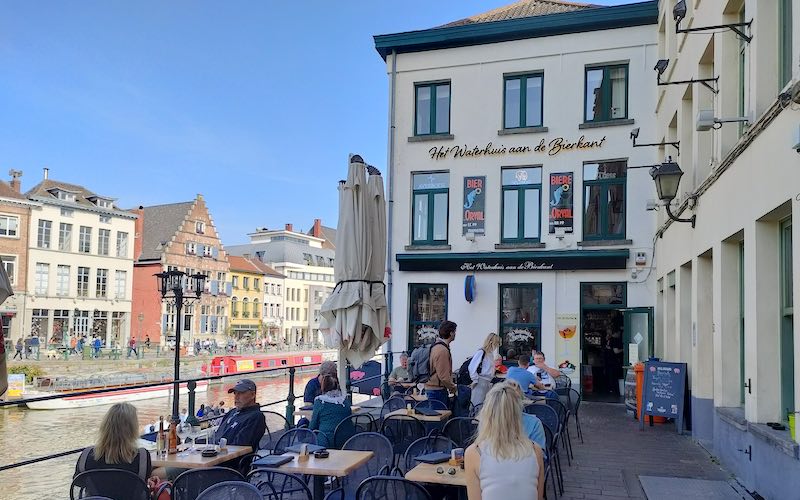
Take a night time tour
Ghent is beautifully lit up at night, so don’t miss the gothic architecture at dusk, between 8-10pm. One of the best things to do in Ghent is the night time tour. These tours with Legends go from Hostel Uppelink at 8pm every evening.
Things to do in Ghent: Further Reading
If you enjoyed this article on things to do in Ghent, you might also like to read…
- Food in Ghent
- Is Ghent worth visiting?
- Churches in Bruges
- Is Bruges worth visiting?
- Things to do in Charleroi
- Solo Travel Belgium
